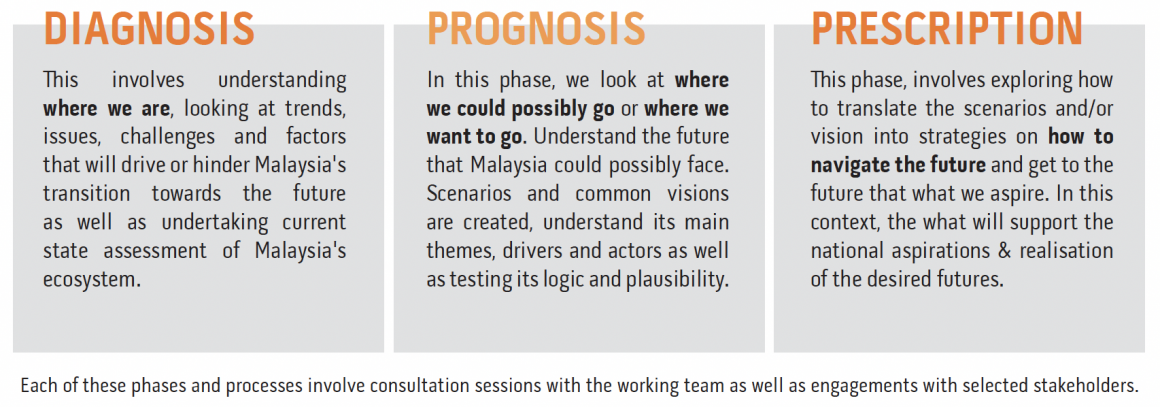Greetings and salutations from all of us at myForesight®. It certainly has been an eventful quarter for us. With the government easing the restrictions on public gathering, we have been conducting various face-to-face activities – workshops, consultations, site visits and trainings – to enable us to get close and better understand the needs and concerns of our stakeholders.
One of the highlights of our engagements was the consultation for the Global Innovation Index. Many have opined that Malaysia should target to be amongst the
top 20 nations in the world. A time frame of 2030 has also been set, raising concerns as to whether the target even makes sense. There is a need to ensure that targets set are based on understanding the gaps, overcoming the challenges, and realising the opportunities to address Malaysia’s innovation ecosystem.
Enter us, using foresight tools to look at this matter. By now you would have been aware that our approach to foresight follows this process:


Therefore, MIGHT has created a data modelling system that allows us to undertake the current state assessment of the ranking, conduct analyses of past data as well as simulate what Malaysia’s rank would be in the next few years. The model provides insights into where Malaysia’s strengths and weaknesses are, understand the relationship and weightage of each indicator and pillar, and what it would take to move up the ranking.
Presently, Malaysia needs to improve by 38.91% from 2022’s value to reach a score that is comparable to the current 20th position in the 2022 report.
This data modelling, a quantitative approach is also supplemented with the qualitative approach of stakeholders’ engagement. Note that this initiative is not the panacea of the innovation ecosystem in Malaysia. It is meant to provide insights to address Malaysia’s ranking and improve its position
But what of the innovation ecosystem itself? Well, the assumption is that any improvement to the ecosystem will be reflected in the indicators and pillars scoring.
In a previous edition of this magazine, we shared our thoughts on the relationship of foresight and innovation where we stressed that “foresight is an innovation provocateur”. The use of foresight will enable organisations and nations to anticipate, identify the signals, explore future opportunities as well as risks and provoke responses to solve the problems of tomorrow before they emerge and meet the needs of the future. Therefore, the use of foresight is paramount and should be part of any innovation approaches.
Countries that have anticipatory innovation ecosystems like Japan and South Korea have seen foresight institutionalised and initiatives conducted regularly with great deal of success. There are numerous reports in the public domain that provide case studies on the matter.
Various books have been written addressing the subject of foresight and innovation, as well as guidebooks and manuals on how to utilise said foresight for innovation. Stanford’s Playbook for Strategic Foresight & Innovation is one such book that is worth your time and consideration.
As usual, we have brought you multiple thoughts and viewpoints about futures and, this time, in the context of innovation as well as competitiveness.
I do hope what is presented in this magazine continues to be of interest to you and adding value to the work you are doing. We look forward to receiving any contributions of content, either in the form of viewpoints or insights that you would like to share with us. Of course, comments are also welcome.
I look forward to hearing your thoughts on this matter.
#StaySafe











